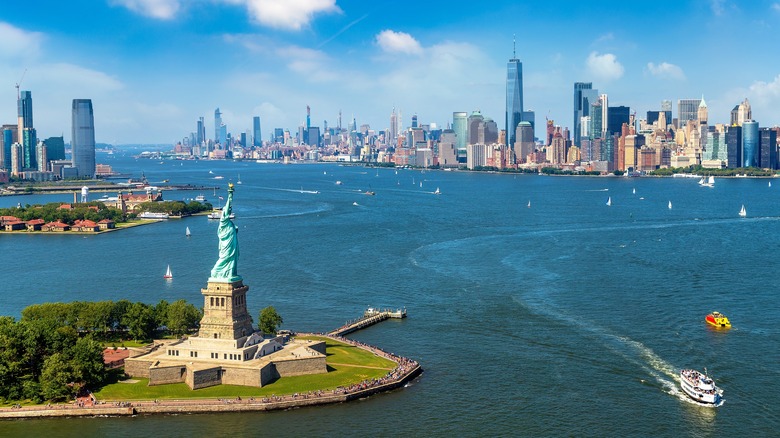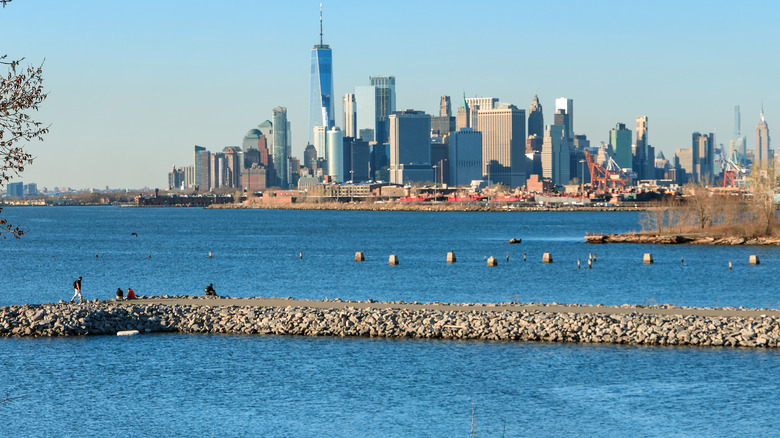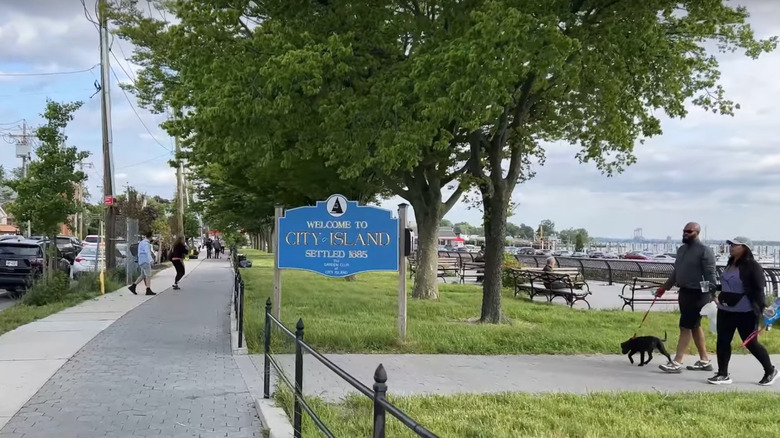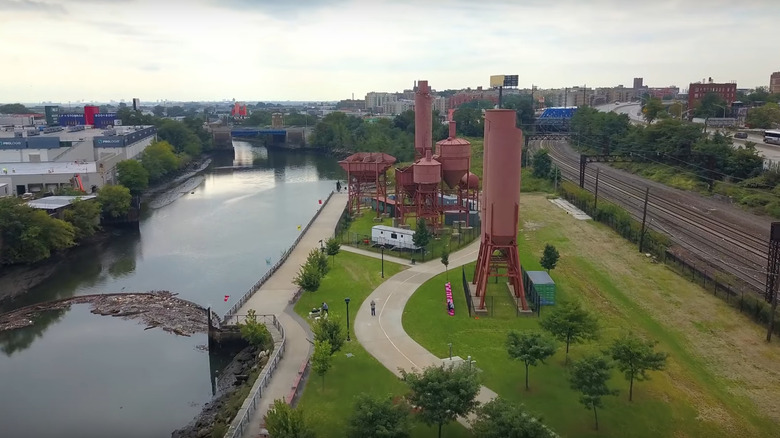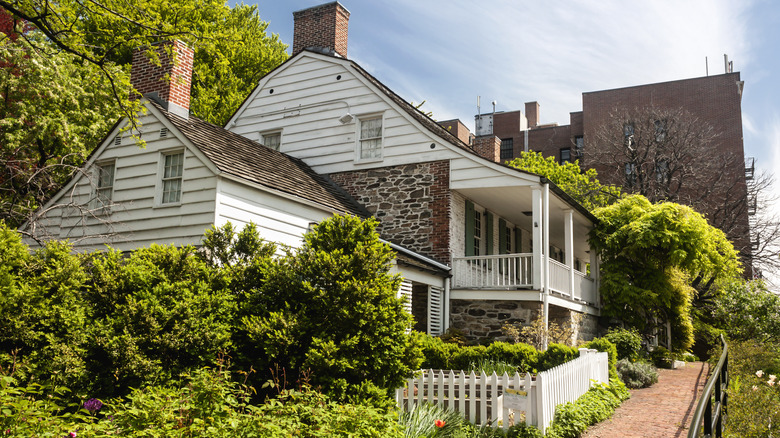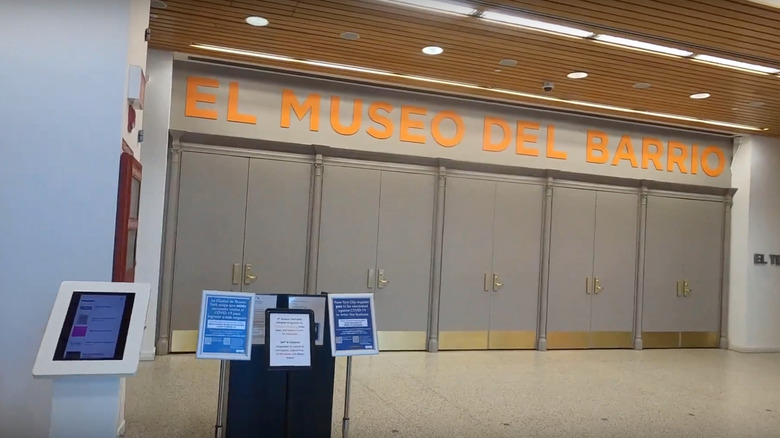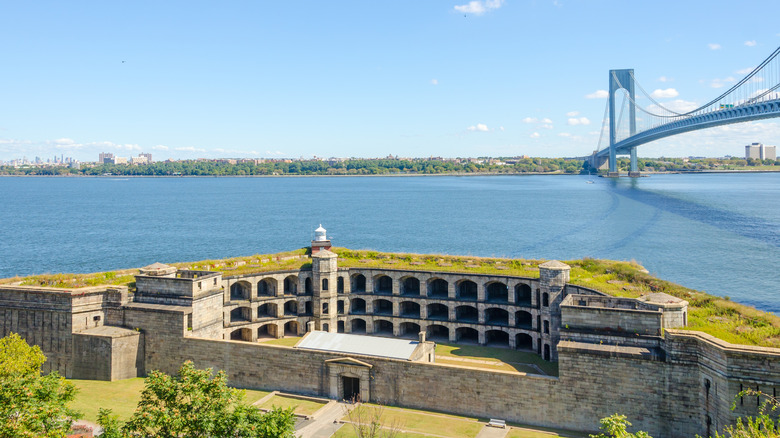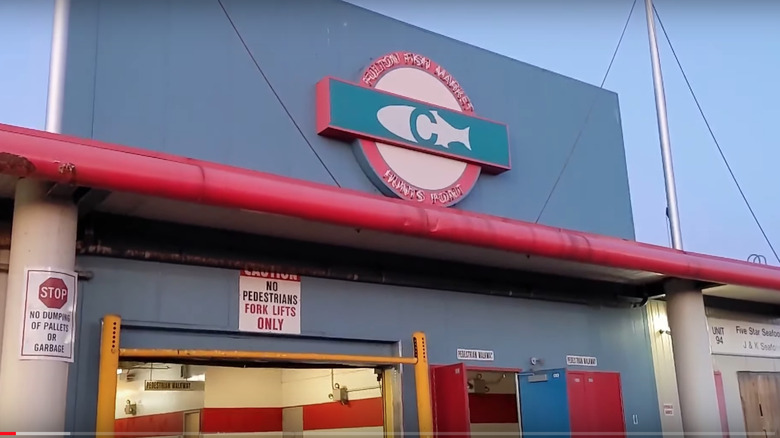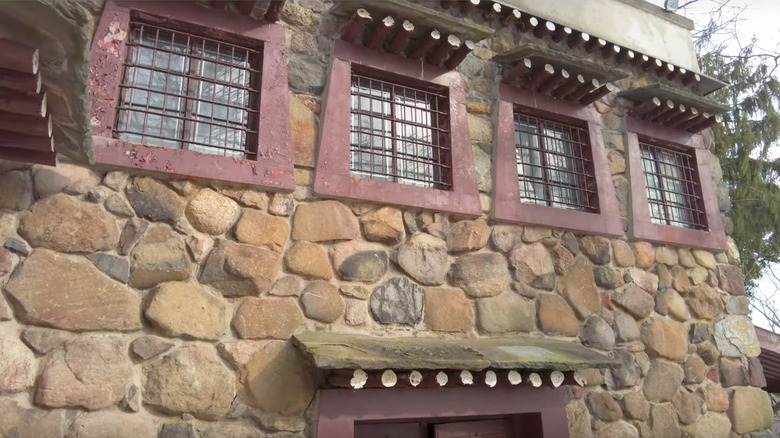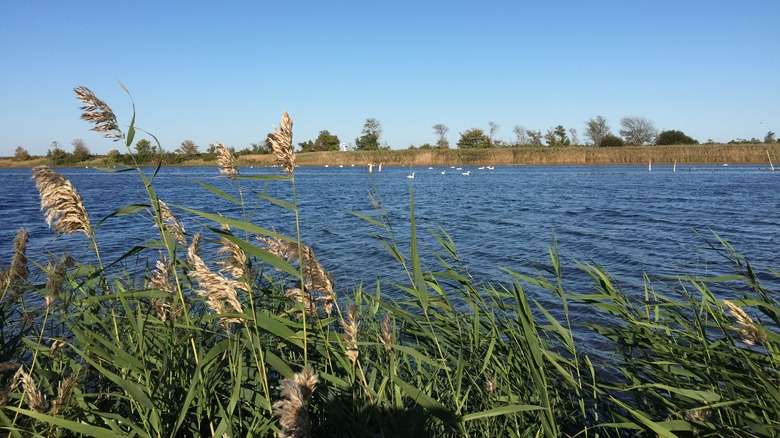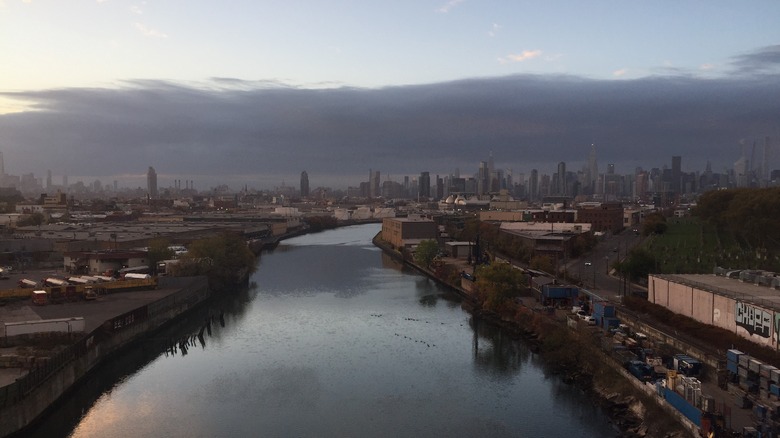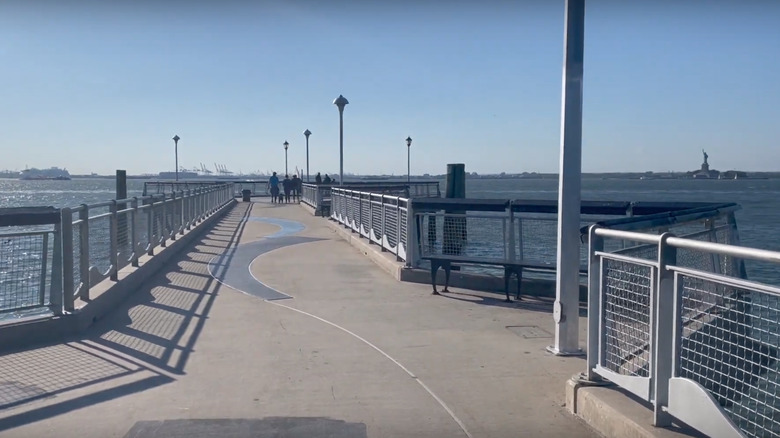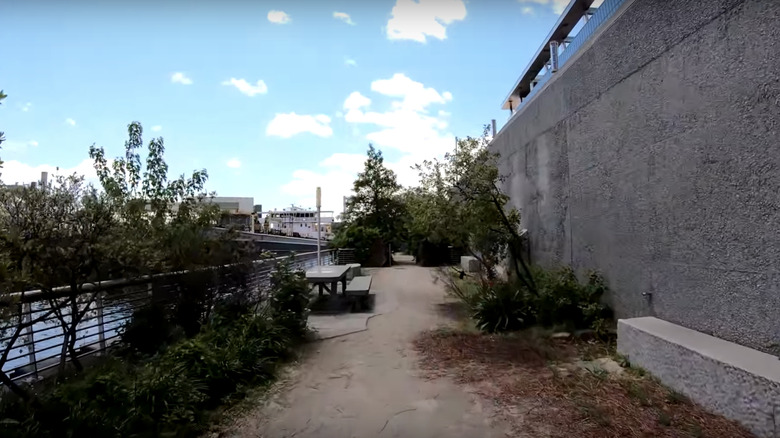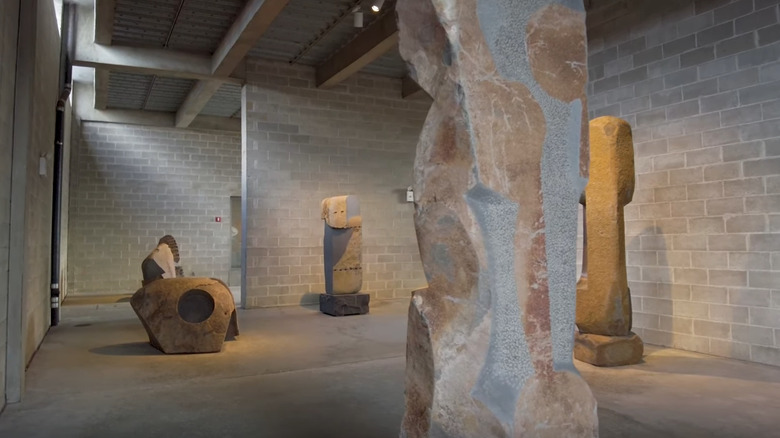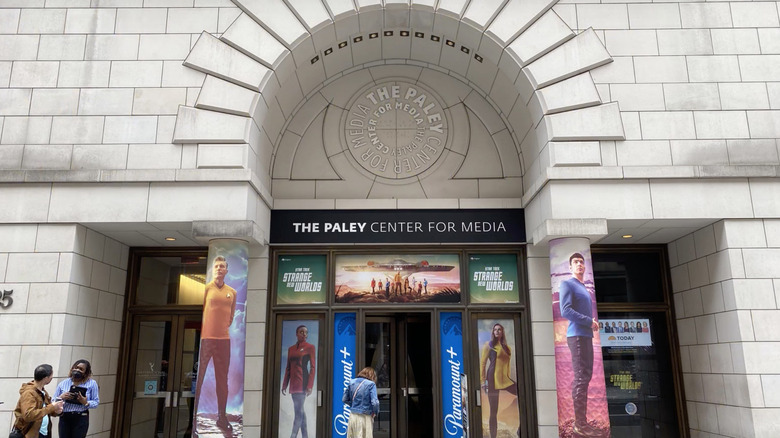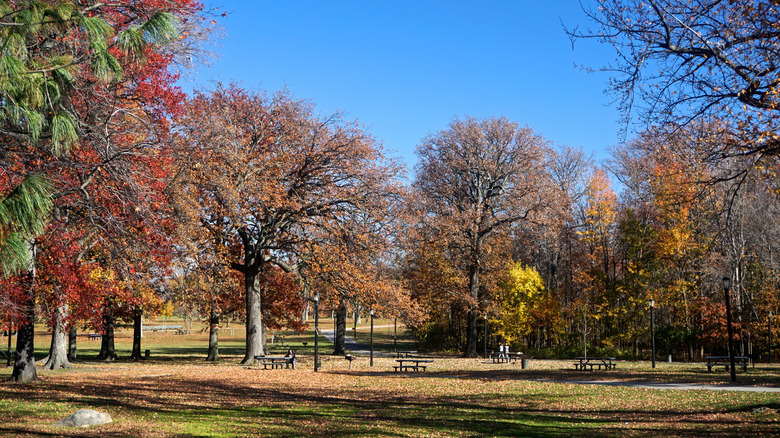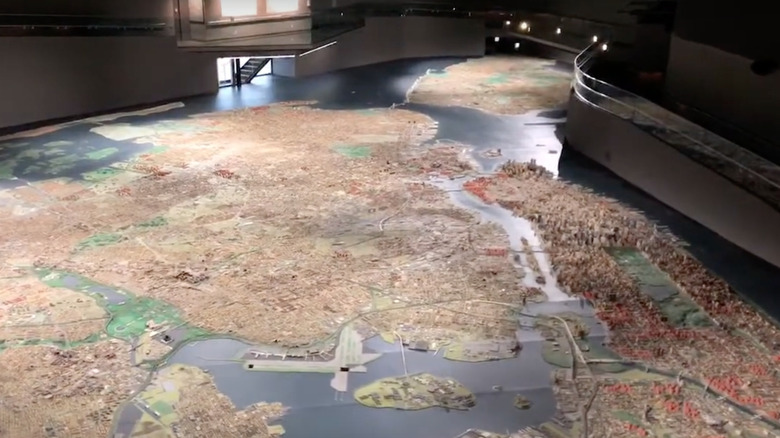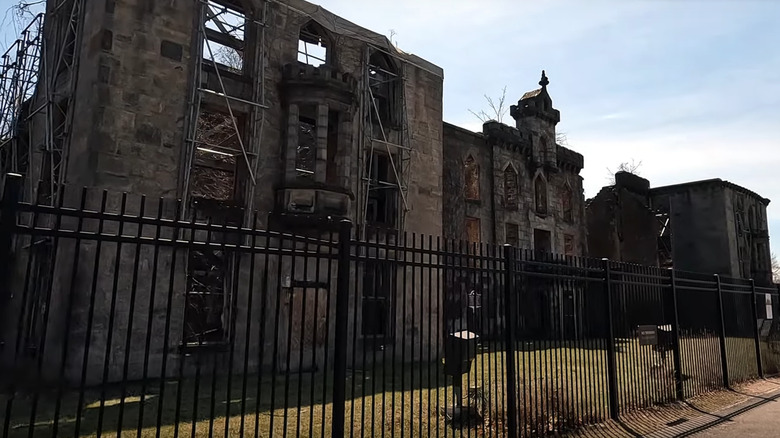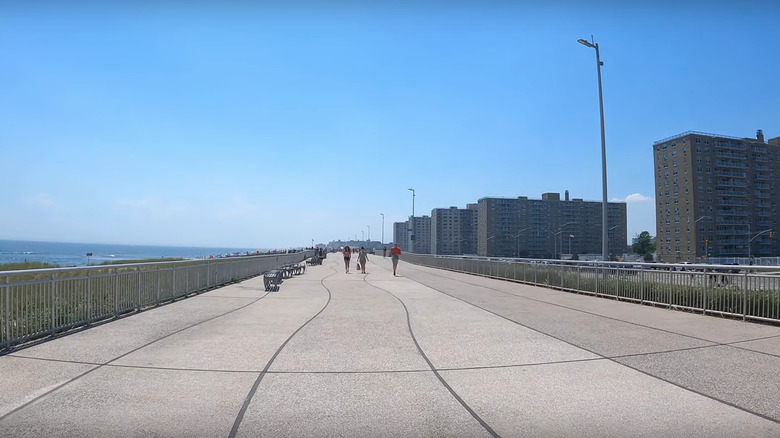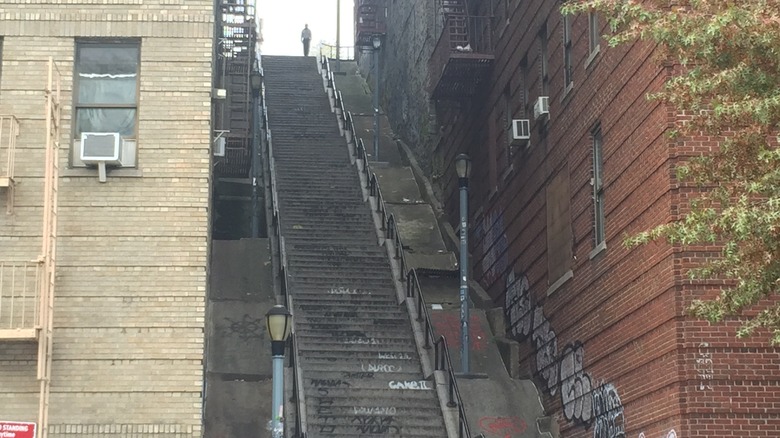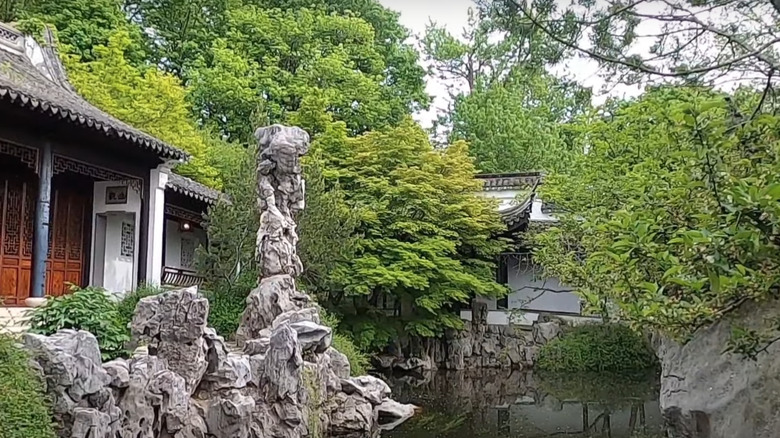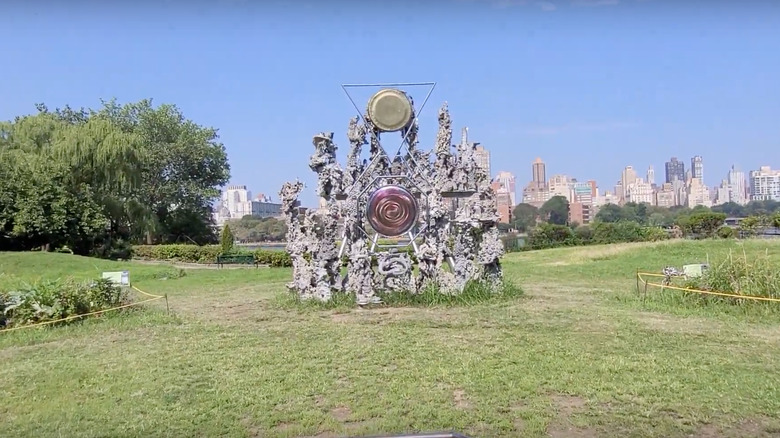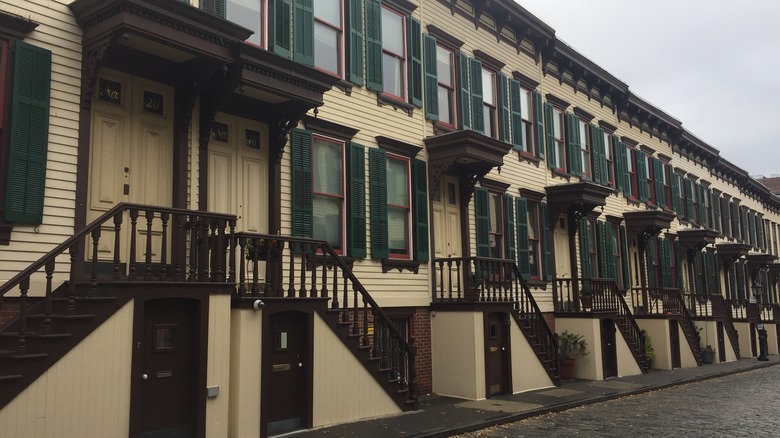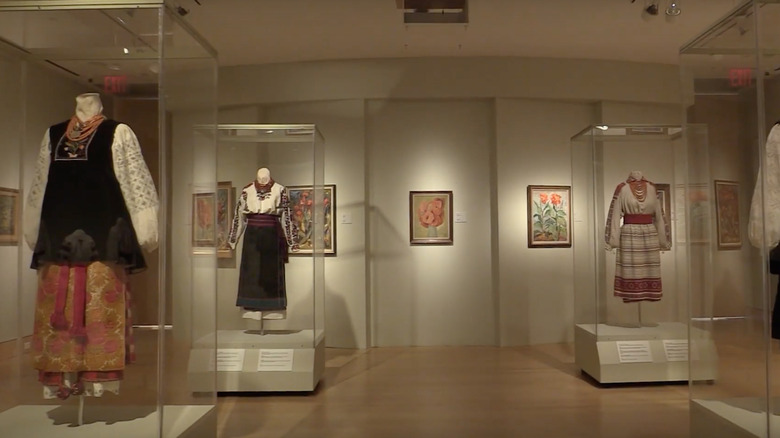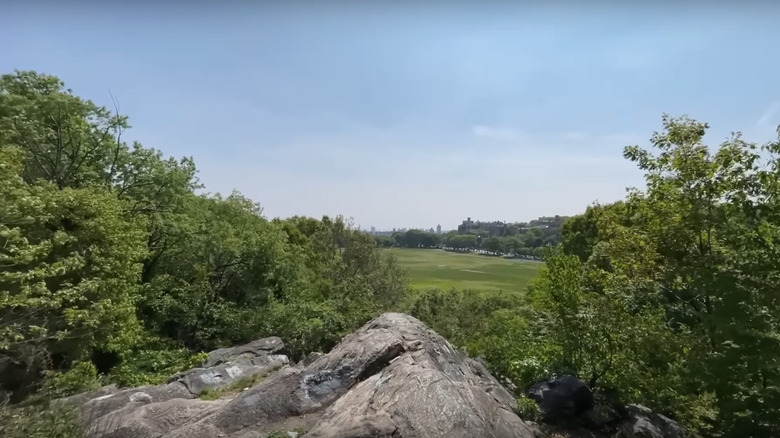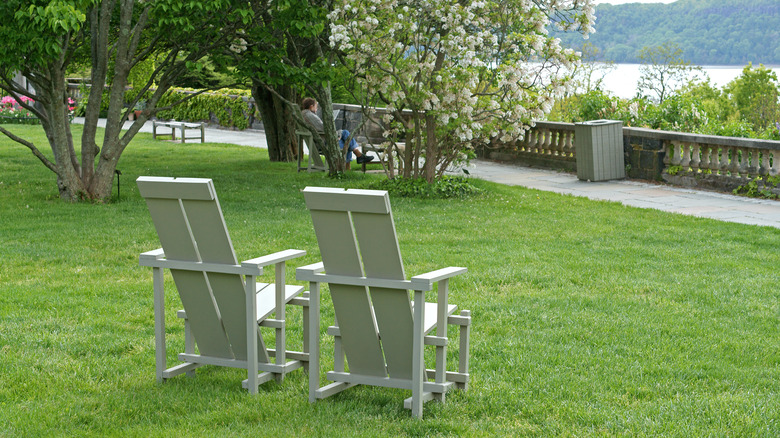27 Underrated Tourist Attractions To Add To Your NYC Itinerary
A city unlike any other in the United States, New York is a top destination for domestic and international tourists for so many reasons. The numbers back this up, and before the pandemic, the city welcomed more than 66 million visitors in one year. Why do they come? For starters, there are the globally recognized buildings old and new, icons unto themselves that just yearn to be seen — the Empire State Building, the Statue of Liberty, the Flatiron Building, the Freedom Tower, and St. Patrick's Cathedral, to name just a handful.
This is where to find tons of world-class museums that will keep visitors entertained for days on end, from the Museum of Modern Art to the Met, and much more. And then there are the ambitious public areas that are a quintessential part of any New York experience, from Central Park to Washington Square Park, from Grand Central Terminal to the Oculus at the World Trade Center. And yet, sticking to these marquee attractions does the rest of the city's riches a grand disservice, because there really is so much to see beyond the tried and tested. For every Bryant Park or High Line, there is a lesser-known slice of urban wonder elsewhere in the city that is just as rewarding, even if it's not high on the public radar. Here are some of the best ones worth looking out for.
Bush Terminal Piers Park
Part of a former port area, this public park opened in 2014 after an extensive overhaul. It sits on the edge of an industrial part of Brooklyn, Sunset Park, and that history is evident from the old factory/warehouse that runs alongside one section of the park, near the soccer and baseball fields.
The best part of a visit here is that it lets travelers appreciate how connected the city is to the water, with rocky stretches that push out toward Bay Ridge Channel and create small tidal pools. There's always a mix of people here, and you might see locals walking their dogs, flying kites, sitting down and taking in the breeze, or admiring the sweeping views of Downtown Manhattan that really are spectacular.
City Island
Wander past seafood restaurants and small local businesses at this Bronx island, and you won't believe you are in NYC. A small slip of an isle that sits just off the main chunk of the Bronx, one of the city's five boroughs, and linked to it by a bridge, this destination feels like a true escape from the Big Apple. Stroll down City Island Avenue, the main drag, and you'll notice the lack of apparent urbanism, causing it to feel like you have arrived at a small New England village.
Independent boutiques mingle with yacht clubs and restaurants that extol their amazing seafood, and the general ambiance here is laid-back, a stark contrast to the hustle and bustle of the rest of NYC. Early June and September are great times to visit, especially when a weekend arts fair fills the sidewalks with stalls and entertainment.
Concrete Plant Park
What almost appears as a repository for oversized sculptures of industrial equipment was actually a former concrete manufacturing facility. This stretch of urban renewal sits close to Bruckner Boulevard, one of the busiest commercial strips of the Bronx, populated by warehouses and auto repair shops, but it is a realm of peace that hugs that Bronx River.
The giant pieces here, painted the color of chocolate or rust, depending on what a visitor wishes to see, were once functioning hoppers and silos for the company Transit-Mix Corporation, a cement manufacturer that operated a facility here from 1945-1987. After the operations ceased, the plant fell into disrepair, a common urban tale of decay exacerbated by dangerous materials left behind and a general sense of despair about the future of the site. But, after concerted community efforts and cooperation by the NYC Parks Department, the plot was reinvented, opening in 2009 with chess tables, pedestrian and bicycle paths, and shaded seating, all of which are great spots to take in this unheralded gem on a sunny day.
Dyckman Farmhouse Museum
This historic farmhouse is the last remaining Dutch farmstead in Manhattan and is home to a museum that traces its storied past. Restored in the early 1900s by the children of one of its earlier owners, it has fascinating period interiors, with fireplaces, old wooden chairs, tables, desks with drop leaves, and paintings that really make visitors feel as though when they enter, they have stepped back in time.
Travelers that come here to the northern part of Manhattan should definitely make time to wander around the gardens, with their pretty wildflowers, planter beds, and sense of urban escape in the middle of what is now a concrete jungle.
El Museo del Barrio
A stretch of the Upper East Side, the posh neighborhood in Manhattan that sits east of Central Park, is where to find the Museum Mile. Along here, some of the city's finest institutions can be found, such as the Metropolitan Museum of Art, the Solomon R. Guggenheim Museum, the Museum of the City of New York, and the Cooper Hewitt. At the northern cusp of this ribbon, visitors will find the often-overlooked El Museo del Barrio, which celebrates the heritage of Puerto Ricans in the United States, as well as other Latino achievements.
Exhibitions take a distinctive, in-depth, and unexpected look at the experience of Puerto Ricans, and other Latins, including recent waves of Mexicans and Dominicans that have immigrated to New York, presenting art in creative, groundbreaking ways.
Fort Wadsworth
This former military outpost on Staten Island is one of the oldest in the country. It sits right under the Verrazano-Narrows Bridge, a grand span that connects Brooklyn and Staten Island, and offers views of the bridge that many don't get to see. Spread out over more than 200 acres along a coastal patch of the island, the fort isn't just an interesting part of the city's history, but it also enables visitors to get striking views of the harbor, bridge, and Manhattan skyline in the distance from its overlook.
The complex was started in the 1800s as part of a string of coastal strongholds aimed at repelling any foreign invasions. Originally constructed from sandstone, it later used granite and brick as its main materials, rebuilt in the middle 1800s, and it continued to serve a military purpose before it was folded into the National Park Service in 1994.
Fulton Fish Market
Named for the street in Downtown Manhattan where it once stood, this fish market, in a large commercial food terminus in the Bronx, is a hive of activity, a noisy, smelly, slice of New York that most tourists will never witness. But catching the action requires a little effort, and visitors will need to get here early in the morning to see all the drama unfold. The original fish market was a short distance from Wall Street in Manhattan, first debuting in 1807, and it sold not only fish but other items as well.
Fifteen years later, the market moved to new premises on South Street, not far away, and more than a century later it was the commercial nexus for one-quarter of all the seafood sold in the country. The whole operation moved to the Bronx in 2005, into a 400,000-square-foot home that cost more than $80 million to build, and while much of the business done daily is wholesale, representatives of some of the city's finest restaurants can be found here in the wee hours snapping up snappers and other fresh finds.
The Ganesh Temple of Queens
This popular temple in Queens has an ornate "gopuram" (tower by its entry), and is a bedrock in its neighborhood of Flushing, Queens, one of the most ethnically diverse parts of New York City. This site was home to a small house of worship from 1970, but the current temple was finished in 1977 and has been drawing religious followers ever since.
Dedicated to the Hindu god Ganesh, a remover of obstacles, this temple is a place of great tranquility and spiritual power, welcome even to nonfollowers of Hinduism. What is even more alluring is its proximity to the Queens' Botanical Garden, and its fantastic temple canteen, which serves up delicious, reasonably priced, super-fresh, South Indian delights, open from 8.30 a.m. to 9 p.m. daily.
Jacques Marchais Museum Tibetan Art
This building in Staten Island was made to look resemble the rustic form of a Tibetan monastery, the perfect stage for the trove of items here. It is located on a hill, close to a golf course and cemetery, and has views of New York waterways like Lower Bay and Raritan Bay. The collection here, not all of which is displayed, is vast, with thousands of works from northern China, Mongolia, and Tibet, some more than 500 years old.
Open from Thursday through Sunday, and only in the afternoons, it showcases a range of artistic mediums, from sculpture to religious reliquaries, from musical instruments to paintings artfully captured on scrolls, and a visit here feels like making a trip to another continent.
Jamaica Bay Wildlife Refuge
Not far from JFK Airport, this wilderness area, incorporating land and water, teems with avian life. With an area of 9,000 acres, the tranquil, natural arena comprises broad bays, marshes, woods, fields, and flats of tidal mud where shorebirds like to scavenge. For birdwatchers, this is paradise in the city, and more than 3,000 bird species (about half of those that live in the Northeast of the United States) have stopped by in the last three decades.
What can one see? Sightings of snow geese, ducks, swans, hawks, and falcons are commonplace, and beyond the abundant bird population here, the refuge is just a gorgeous place to reconnect with the environment and a way to escape into the wilds while still being in the city.
Kosciuszko Bridge
Linking Queens and Brooklyn, and tastefully lit at night, this bridge is actually not much to see per se, and it is frequently choked with traffic (it forms part of one of the city's most busy expressways, and is close to the entry point to another, the Long Island Expressway). And yet, by dint of its location, it has views over Newton Creek and onto the Manhattan skyline that are stunning.
A cycle and walking path on the west side of the bridge, which is cable-stayed and has two sections that are separated in the middle, allows visitors to look across over Calvary Cemetery, along the winding creek that adds another visual element to the panorama, and to soaring towers across the East River. While the views are breathtaking during the day, at night the whole scene becomes even more spectacular. After dark, the skyline is lit, appearing like a series of glinting gems, while the bridge's cables, bathed in deep, pastel hues, look like they belong to a spaceship about to land.
Louis Valentino Jr., Park and Pier
The views of waterways and the Statue of Liberty are worth the trip out to this part of Brooklyn, which played an important role in the city's shipping past, while still being linked to it. In fact, this compact patch of greenery with a long pier that reaches out into Buttermilk Channel sits a short distance from the Brooklyn Cruise Terminal.
Travelers can take to the water during the summer months with kayaking trips operated by local outfitters Red Hook Boaters from the park, while there are free film screenings here during the warmer months, courtesy of Red Hook Flicks, making it a hang-out that's popular with locals.
Newton Creek Nature Walk
Near a shiny wastewater treatment plant, and along the waterway that separates parts of Brooklyn and Queens, this walk feels both urban and not. Extending about one-half mile along the water, near the water facility and along Newton Creek, it first debuted in 2007, though was added to in 2021 following the opening of a new section.
It aims to draw a link between water and life, done not only through the location of the walk — by a waterway and the wastewater plant — but also through features like the entry gates that are shaped like waves, and sculpted sections that resemble a boat. Along the route, visitors will encounter native plants like swamp white oak and eastern red cedar.
Noguchi Museum
For fans of art, the name Isamu Noguchi will immediately strike a chord. The sculptor, half-American and half-Japanese, and raised in the United States and Japan, is known for this vast oeuvre of sculpted works, pieces that inhabited different genres, from large outdoor pieces to ceramics, from lighting to stage sets. He also worked across materials, and works were made using steel, marble, iron, wood, granite, and even water.
You can peruse a huge selection of pieces by this seminal artist, including models, sculptures, and drawings, both indoors and outside, at this museum in the Long Island City part of Queens. The large, industrial building sits across from the location of Noguchi's studio, a fitting homage to this artistic great who spent many of his years in the city (he died here in 1988).
Paley Center for Media
Formerly known as the Museum of Television and Radio, the Paley Center For Media is a great place for anyone fascinated by the history of TV and radio, with more than 150,000 programs that look back over a century of these mediums. It's also close to the cultural behemoth, the Museum of Modern Art, which sits one block to the north, and can be easily combined with a visit there — assuming you have the energy.
Visitors to Paley can pore over an archive that contains news, sports, documentaries, comedy, and even old advertisements for anyone that is nostalgic for jingles and ditties from their youth. It's like an encyclopedia for the broadcast arts, with the archive available at each viewing station; large consoles can be watched by up to four people, ideal for a family. The center also holds debates on the rapid changes in media, and film and television screenings.
Pelham Bay Park
This sprawling park in the Bronx — the largest park in New York City — has plenty of things to do, and large swathes of green space that will let visitors leave the city behind. It's split into two parts, separated by the Hutchinson River, and visitors will pass through it en route to City Island (mentioned above).
There are a number of parts of it not to miss. The Kazimiroff Nature Trail, named for a historian born in the Bronx, showcases the towering spruce and pine trees here (and the owls that live in them), as well as some large rocks that were used in rituals by local Native Americans prior to European conquest. Elsewhere in the park, visitors will find monuments, grand sculptures, sections of forest, and even a broad, curling, sandy beach that gets busy during the summer.
Queens Museum
Unless they are lucky enough to be on the correct side of a plane, and flying the appropriate route, travelers are unlikely to see that sweeping overview of the city, the kind that appears on postcards or movies and TV shows set in NYC. But visit the Queens Museum, located in Flushing Meadows Corona Park (where the U.S. Open tennis tournament is played), and you'll be able to see the entire expanse of the city — or at least a model of it.
The Panorama of New York City is one of the museum's permanent exhibitions and is not to be missed. First constructed for the 1964-1965 World Fair, it took three years to complete, and covers almost 10,000 square feet of exhibition space (it has undergone renovations to keep it current). Standing next to it, visitors will be able to get a real grasp of the layout of the city, with models scaled 1:1200 (so one inch is the equivalent of 100 feet), and will be able to make out lesser known landmarks like the Newton Creek Wastewater Plant, as well as the more familiar bridges, buildings, and stadiums.
Renwick Smallpox Hospital
This former hospital, on Roosevelt Island, might be surrounded by iron-rail fences which prohibit access, but it's still an eerie sight. Its genesis dates to 1856 when it was opened as a hospital specifically aimed at tackling the problem of smallpox. Over the decades, it changed to become a nursing school and later fell into disrepair. Despite the unrelenting action of the elements and the environment which both contribute to the building's slow decay, it was designated as a National Landmark by the National Register of Historic Places in 1972.
Today, a nonprofit group called Friends of the Ruin aims to restore the building in parts to make it a memorial that all can safely visit. That said, even from beyond the fences around it, it is a haunting piece of architecture that will long stay with any visitor.
The Rockaways
A great beach getaway at the end of Queens, and south of Jamaica Bay, this part of the city was greatly affected by Hurricane Sandy in 2012. The strong winds and surging seas wreaked havoc on homes and the boardwalk, a winding piece of seaside history that had been open since 1931. After Sandy, the city stepped in with a rehabilitation plan, and in the summer of 2017, the restored boardwalk was opened, with wide concrete paths and places to sit.
The beach itself is broad and topped in soft sand, fronting the Atlantic Ocean and accessible by both subway and water ferry that departs from Wall Street in Manhattan, and Sunset Park in Brooklyn.
Seaside Wildlife Nature Park
This swathe of greenery in the southeast of Staten Island is a treasure chest of flora and fauna. With grassy expanses ceding to the salt marsh on Great Kills Harbor, this is where the intrepid traveler will find more than 60 species of birds — among them cormorants and ospreys — as well as those nomads of the seafront, the horseshoe crab. Among the greenery are pine trees, white oaks, mulberry bushes, and pretty milkweed plants.
But, what makes this part of the city most popular with visitors is the playground, themed with a nautical overview as a nod to the location and the tradition of seafaring in the area, and a place of wild entertainment for neighborhood kids, and those from further afield that make the trek out here.
Shakespeare Steps
Watchers of the movie "Joker" will understand why Joaquin Phoenix won an Oscar in 2020 for his role of the title character — his portrayal was heart-wrenching, moving, unnerving, and terrifying, a remarkable tour de force by the talented actor. One of the most famous scenes in the film takes place when his character wiggles and dances down a long, vertiginous set of stairs, a watershed moment when he finally feels comfortable in his skin.
That iconic scene was filmed in the Bronx, on a set of steps that descends from Anderson Avenue, a little north of Yankee Stadium. Come for a visit, it's close to the 4 Train stop at 167 Street, and you can re-enact the scene, though you are not likely to be alone — these, after all, are a functioning set of city steps that serve a very practical purpose.
Snug Harbor Cultural Center & Botanical Garden
It's hard to pin a label on this destination on Staten Island, there is so much variety and so much to see. This is where to find the Newhouse Center of Contemporary Art, the leading repository of modern art on the island, with 15,000 square feet of space open for exhibitions. Another space in the center is home to a maritime collection, while there is also a Children's Museum and an institution that looks at the history of Staten Island.
Many come here to wander around the numerous gardens, which include a rose garden, a butterfly garden, and even a Chinese Scholar's Garden, where buildings have sweeping rooflines that transport visitors to Asia.
Socrates Sculpture Park
A short walk away from another great realm of sculpture, the Noguchi Museum, this waterfront outdoor arts park in Long Island City, Queens, is a wonderful excursion. There are always new exhibitions on show here, and a recent one featured a complex structure of scaffolding that reflects the city's skyline, while pieces of vegetation dotted up high in the scaffolds represent the fragility of the coast and its ecology.
Yet the park isn't just about art, and there are many other events that draw visitors, from musical performances (including opera), workshops on nature, meditation sessions at sunset, and morning yoga.
Sylvan Terrace
Here is an instance of a blink-and-you-will-miss-it site. A short, single block in Upper Manhattan, and set right by Morris-Jumel Mansion, the oldest house in Manhattan, this stretch of houses seems to belong to another era. Sylvan Terrace was once just a driveway without homes, a road that carriages plied from the mansion as they headed out to the city, and you can almost picture this since the center of Sylvan Terrace is still paved with cobblestones.
The houses were added in the late 1800s, made of wood, and notable for their vibrant yellow and brown paintwork, and bright green shutters. Tucked among apartment buildings, this block really is an arresting sight, and one that will have you gaping in wonder.
Ukrainian Museum
How many places in the United States can lay claim to a museum celebrating the traditions of this country currently under siege? Located in the East Village, which for many years had a strong cadre of residents from Ukraine, and that is home to an area called Little Ukraine, this small museum is a fabulous way to learn more about this Eastern European country.
Drop by, and you might see pretty pieces of folk art, tokens that are perceived as good luck charms, made from leather, wood, and eggs, as well as artfully embroidered items of clothing, and also paintings by leading Ukrainian artists.
Van Cortlandt Park
A huge park in the north of the Bronx that bleeds into Westchester, the county above New York City, this is an amazing expanse of nature. It's larger than Central Park and is a fascinating window into the geological past of this part of the world. Thousands of years ago, the city sat under giant glaciers, and when these hunks of ice retreated, they left behind a wildly varied landscape, and Van Cortlandt Park is evidence of this.
Visitors will stumble upon broad flat fields, gentle inclines, steep ridges, and plenty of rocks, with dolomite and schist prevalent. Adventurers can explore miles of hiking trails that shuffle through trees, and wander around wetlands, woods, and deep areas of forest. You'll truly forget you are in New York City.
Wave Hill
Another example of green goodness in the Bronx, this 28-acre site is beautifully landscaped, and perfect for photos. Wave Hill describes itself as an open-air museum, but most visitors will see it as a botanical wonder, where thousands of trees, plants, vines, shrubs, and flora, appear both in finely manicured form and also gorgeously wild.
Guests will be able to marvel at the plants in greenhouses, the beautiful forms and shapes in the gardens, and even get lost in a wood. The park is open most days of the week, but visitors on a budget should plan to come on a Thursday when entry is free, something that is never underrated.
